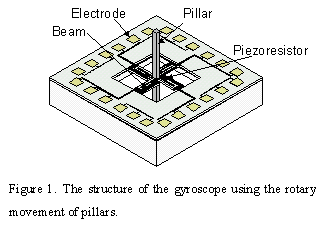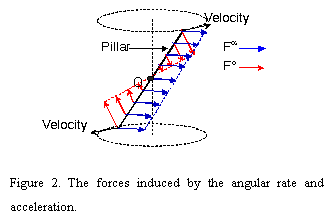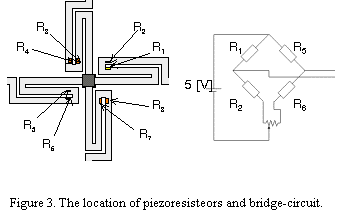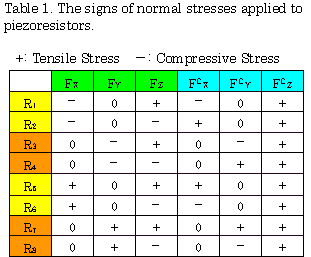

A
Piezoresistive Micro Gyroscope |
Satoshi Nakano, Toshiyuki Toriyama* and Susumu Sugiyama
Faculty of Science
and Engineering, Ritsumeikan University
1-1-1 Noji-Higashi, Kusatsu, Shiga 525-8577, Japan
*New Energy and Industrial Technology Development
Organization
Higashi-Ikebukuro, Tokyo 170-6028, Japan
Keywords: micro gyroscope, angular rate, rotary movement, piezoresistor
We designed a piezoresistive micro gyroscope using the rotary movement of pillars. The design of the micro gyroscope is based on the Coriolis effect. The structure of the micro gyroscope is shown in Figure 1. The micro gyroscope consists of a cross-shaped and folded silicon beam with p-type Si piezoresistors, and pillars at the center and both sides of the beam. The cross-shaped and folded silicon beam is 50 mm - wide and 50 mm- thick. These piezoresistors are formed at the locations where the maximum compressive and tensile stresses are applied.


The micro gyroscope uses the rotary movement of pillars induced by the four electromagnetic actuators. When the angular rate is applied to the micro gyroscope, the Coriolis force changes the stress in the beam. The micro gyroscope detects the change of stress in the beam via the piezoresistors. The Coriolis force FC and inertial force Fa that were applied to the pillar by the angular rate and acceleration are shown in Figure 2. The influence of acceleration can be removed by the combination of the configuration of both side pillars in Figure 1 and the bridge circuit. As can be seen from Figure 3 and Table 1. When the inertial force Fx is applied to the micro gyroscope, output voltage of the bridge is zero due to the same sign of the pairs of (R1, R2) and (R5, R6). On the other hand, when the Coriolis force FCx is applied to it, output voltage can be obtained due to the different sign of the pairs. The pairs of (R3, R4) and (R7, R8) are same idea as the pairs of (R1, R2) and (R5, R6) on this point.


We analyzed the sensitivity of the micro gyroscope using MEMCAD, taking into account the non-linearity of piezoresistors and the fracture strength of the cross-shaped and folded silicon beam. We calculated the Coriolis force from the vibratory velocity, the mass, the radius of rotary movement and the angular rate. As a result of the analysis, the sensitivity of the micro gyroscope with the cross-shaped and folded beam was 4.0 nV / deg /sec.